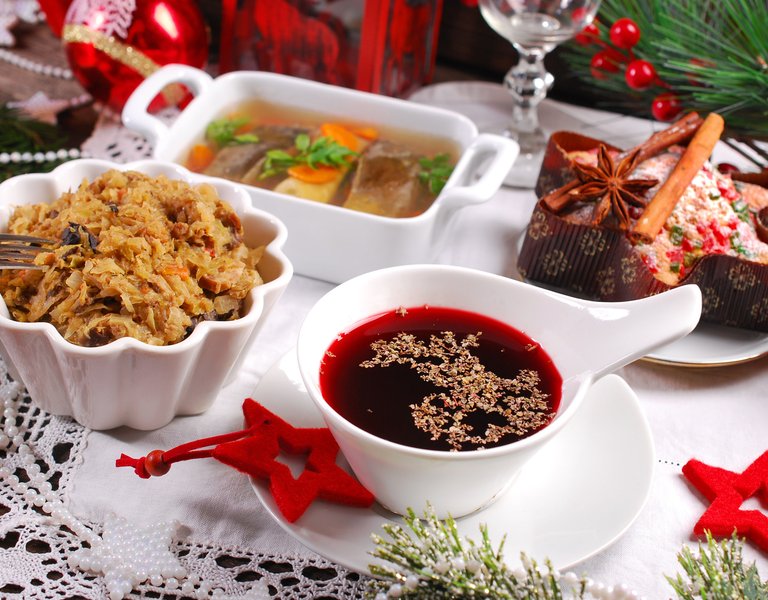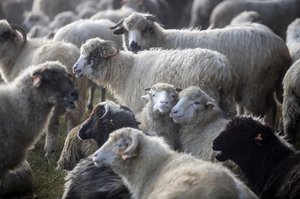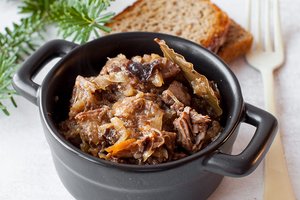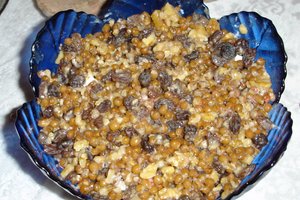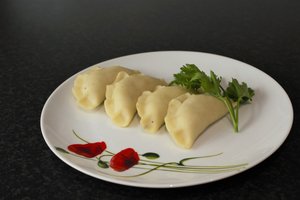Poland’s traditional Christmas Eve dishes
Carp, borscht, as well as kutia made of groats, poppy seed, cabbage with peas, Silesian gingerbread and fish head soup. Christmas Eve dishes in Poland vary depending on which part of the country you are in, but almost all dinners on this special day consist of 12 dishes and dried fruit kompot.
On Christmas Eve, December 24th, the appearance of the first star on the sky marks the beginning of one of the most beautiful evenings in the year. An entire day of fasting ends with a prayer, the sharing of the Christmas wafer and wishes of good luck. After that, supper is served – and although it is meant to be a fasting meal, in many cases it will likely lead to heavy overeating.
After devouring the twelve dishes, families leave the dinner table to unpack presents, which are placed under the Christmas tree – decorated with baubles, garlands and colourful lights.
Christmas Eve is full of symbolism, both in terms of the dishes served and their number: despite common belief, there have not always been 12 dishes. In earlier times, sometimes three, five or seven (always odd numbers) dishes were served.
“The tradition of having an odd number of dishes probably came from ancient magical beliefs. It is open, so it gives the basis for multiplying what is on the table to make the number even”, says Robert Piotrowski, the head of the ethnographic division of the Museum of the Mazovian Countryside in Sierpc, when asked by Polska.pl. He adds that the current number of dishes, twelve, is derived from traditions observed by the nobility and minor gentry. – Twelve referred to the number of the Apostles and months of the year. It was intended as a wish for sufficient amount of food for each month of the next year, he explains. Strength and luck was to be guaranteed by tasting each of the dishes.
“In earlier times, Christmas was regarded as a continuation of the festivity honouring the dead that started on November 1st. People believed that the souls of the departed sit at the table. Hence the sleep-inducing poppy seed dishes, which were believed to placate the souls of the dead when added to food”, explains Robert Piotrowski. In some parts of Poland, the meal for the departed was cast into the fire. In other regions, it was eaten in silence to emphasise the solemnity.
Christmas was considered a prophetic day, which helps explain a number of related superstitions. For example, it was believed that crying on Christmas Eve meant crying until next the Christmas. It was also believed that the future could be predicted using a blade of grass from under a tablecloth – a green one meant good luck, a blackened one –bad luck. The custom of putting a carp’s scale into one’s wallet has survived until today. It is supposed to ensure wealth for the entire year.
Polish Christmas Eve dishes
Throughout history, Polish Christmas Eve suppers included a soup based on fermented product, kutia, or noodles with honey and poppy seed, and fish. Uszka – small pierogi (dumplings) which are served with borscht or with sauerkraut and mushroom-filled pierogi started to be served in more recent times.
 Sour soup
Sour soup
Typical soups served on Christmas Eve include sour rye soup (also known as white borscht), red borscht soup traditionally served with uszka, and mushroom soup. All of these soups are made with fermented ingredients. This may be rye flour, in the case of sour rye soup, or sauerkraut. Mushroom soup, which was eaten on Christmas Eve in parts of Poland such as Mazovia, was prepared on a sauerkraut base fermented in a barrel. – The secret was an excellent combination of two tastes: sweet and insipid mushrooms, which burst between the teeth, and sauerkraut, explains Robert Piotrowski.
Usually, only one type of soup is served on Christmas Eve. The mountaineers of Podhale are the exception. They eat both borscht and mushroom soup during their Christmas Eve supper. An interesting variation of both soups is the Pomeranian borscht with mushroom noodles.
Moczka and siemieniotka
Traditional Silesian Christmas Eve soup has one of the most unique combinations of tastes in Polish cuisine. It is made from a special kind of gingerbread, almonds, raisins, and dried fruit: apricots, pears, figs, plums, and hazelnuts. All these products are soaked in dark beer or vegetable and carp head stock. Every Silesian home has a different recipe, but the universal rule states that moczka cannot be sweet or resemble a vegetable soup with fruit. Another soup that is typical for Silesia is siemieniotka, also known as konopiołka, which is made of flax seed and ground millet groats. It is quite bitter and belongs to the most ancient dishes related to Christmas Eve. Flax seed is crushed and then combined with carp head stock and ground millet and buckwheat groats.
 Noodles with poppy seed
Noodles with poppy seed
Mazovian housewives took great care to shape them as ears of wheat. They were called rolled noodles, and they were supposed to be a sign of an abundant harvest. The larger and rounder they were, the better the wheat would be in the summer. In Mazovia, mead mixed with water was poured onto them and poppy seed, which replaced the previously used pearled barley, was added. In Silesia, noodles were sometimes substituted for challah bread with honey and poppyseed, and served cold. In Podhale, the more popular noodles are called hałuski or rzezańce, they are made of the same kind of dough as pierogi, boiled, and served with buttermilk soup.
Kutia
Made of roasted pęczak (pearled barley) to which a mixture of mead and water is added, kutia is one of the most popular dishes in Eastern Poland. Sometimes raisins, nuts and poppy seed are also added. In Białystok, it is known as kucja, east of Warsaw it is on occasion called kuczija. In Kresy and Ukraine, where kutia is also a Christmas Eve dish, it is believed that indispensable ingredients  include “a bit of eternity and the happiness of the saints in heaven”. The ingredient of kutia that represents eternity is wheat, which is reborn every year, and the carefree life of saints is represented by honey. These are not the only religious connotations of that dish. “It used to be carried into the room on the knees, and a burning candle was placed in the middle of the bowl, which was supposed to be the symbol of the connection with the dead”, says Robert Piotrowski
include “a bit of eternity and the happiness of the saints in heaven”. The ingredient of kutia that represents eternity is wheat, which is reborn every year, and the carefree life of saints is represented by honey. These are not the only religious connotations of that dish. “It used to be carried into the room on the knees, and a burning candle was placed in the middle of the bowl, which was supposed to be the symbol of the connection with the dead”, says Robert Piotrowski
Dried fruit kompot
This dish cannot be absent from any Christmas Eve dinner table in Poland, although in some parts of the country it takes on the form of dried fruit soup. Dried apples, plums, pears and apricots, and sometimes almonds, are soaked with water and served for better digestion. This is the only Christmas Eve dish praised by dieticians for its fibre, vitamin and mineral content. Of course, this is assuming that no sugar is added during the process.
Carp, herring, and tench
Fish, the main type of food served at Christmas Eve dinners of the Polish nobility, were not always that common with the rest of the populace. With the latter, fish would often be served if there was a river close to the village. Otherwise, families would go without a fish dish or use herring from the Baltic Sea, which was cheap and easily available. For rich Poles, fresh water fish was the basis of a Christmas Eve feast.
 Apart from carp and tench in aspic, fried pike, perch and sturgeon cutlets were served in Warsaw. Fish were particularly abundant in Pomerania, where various carp dishes (served with butter, garlic sauce, stuffed, fried) were accompanied by flounder in aspic, trout with almonds, pike in horseradish sauce, herring (fisherman style, in cream, pickled). Nowadays carp (fried and in aspic) and herring are necessary parts of the Christmas Eve supper. Fish a la Grecque is also a common dish.
Apart from carp and tench in aspic, fried pike, perch and sturgeon cutlets were served in Warsaw. Fish were particularly abundant in Pomerania, where various carp dishes (served with butter, garlic sauce, stuffed, fried) were accompanied by flounder in aspic, trout with almonds, pike in horseradish sauce, herring (fisherman style, in cream, pickled). Nowadays carp (fried and in aspic) and herring are necessary parts of the Christmas Eve supper. Fish a la Grecque is also a common dish.
Cabbage with mushrooms or peas
Bigos is a traditional dish and a part of Polish, Lithuatian and Belarussian cuisine. Its basis is sauerkraut and fresh cabbage, which is cooked slowly for a long time (preferably a few days) with meat, and on Christmas Eve it takes the form of a fasting day meal and includes mushrooms. In some parts of Poland, such as in Podhale, these are substituted with cabbage with peas. Peas, added to the majority of Polish dishes as a source of starch before potatoes were introduced, is ground and added to boiled cabbage. Then, the dish is seasoned with salt, pepper, caraway, and herbs. Traditionally, cabbage with peas was a popular wintertime dish. It was prepared for a few days, and it made it possible to spend time spinning wool or weaving cloth without any breaks that would be needed for cooking.
Pierogi
They are an indispensable part of the Christmas Eve supper in all parts of Poland. They have been known in Poland since the 13th century, and were probably brought over from the Far East. In the past they were cooked exclusively for holidays. Each housewife had her own recipe that had been in the family for many generations. This is why Poles have so many recipes for the perfect pierogi dish. They often differ in the texture of the pastry, compactness, shape and size of frills. Pierogi with sauerkraut and mushrooms are a variety that is most often found on the Christmas Eve table.
KAROLINA KOWALSKA
22.12.2015

